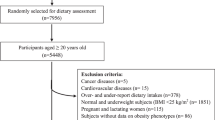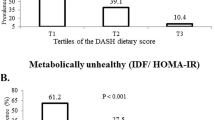Abstract
Purpose
Epidemiologic data linking adherence to the dietary approaches to stop hypertension (DASH) diet and metabolic abnormalities is sparse and inconsistent. The association between habitual intake of the DASH diet and metabolic syndrome (MetS) has not been investigated in the Middle East. We aimed to determine whether usual adherence to the DASH dietary pattern was associated with MetS in a group of Iranian women.
Methods
This cross-sectional study was conducted in 2012 among a representative sample of Isfahani female nurses. A validated, dish-based semiquantitative food frequency questionnaire was used for assessing usual dietary intakes. The DASH score was constructed based on 8 main foods and nutrients emphasized or minimized in the DASH diet. The MetS was defined according to the Joint Scientific Statement.
Results
After controlling for potential confounders, individuals in the highest tertile of the DASH diet score had 81 % lower odds of MetS than those in the lowest category (OR 0.19; 95 % CI 0.07–0.96). Further, adjustment for body mass index slightly weakened the association (OR 0.37; 95 % CI 0.14–0.91). Participants with the greater adherence to the DASH diet were 54, 73, 78, and 80 % less likely to have enlarged waist circumference, hyperglyceridemia, low HDL-C levels, and high blood pressure, respectively, compared with those in the lowest tertile. No significant association was seen between consumption of a DASH diet and abnormal fasting plasma glucose.
Conclusions
Adherence to the DASH eating plan was inversely associated with the odds of MetS and most of its features among a group of Iranian women.
Similar content being viewed by others
References
Suzuki T, Hirata K, Elkind MS et al (2008) Metabolic syndrome, endothelial dysfunction, and risk of cardiovascular events: the Northern Manhattan Study (NOMAS). Am Heart J 156:405–410
Ford ES (2005) Risks for all-cause mortality, cardiovascular disease, and diabetes associated with the metabolic syndrome: a summary of the evidence. Diabetes Care 28:1769–1778
Ford ES, Li C, Zhao G (2010) Prevalence and correlates of metabolic syndrome based on a harmonious definition among adults in the US. J Diabetes 2:180–193
Fakhrzadeh H, Ebrahimpour P, Pourebrahim R, Heshmat R, Larijani B (2006) Metabolic syndrome and its associated risk factors in healthy adults: a population-based study in Iran. Metab Syndr Relat Disord 4:28–34
Esmaillzadeh A, Mirmiran P, Azadbakht L, Etemadi A, Azizi F (2006) High prevalence of the metabolic syndrome in Iranian adolescents. Obesity (Silver Spring) 14:377–382
Djousse L, Padilla H, Nelson TL, Gaziano JM, Mukamal KJ (2010) Diet and metabolic syndrome. Endocr Metab Immune Disord Drug Targets 10:124–137
Hu FB (2002) Dietary pattern analysis: a new direction in nutritional epidemiology. Curr Opin Lipidol 13:3–9
Appel LJ, Moore TJ, Obarzanek E, DASH Collaborative Research Group et al (1997) A clinical trial of the effects of dietary patterns on blood pressure. N Engl J Med 336:1117–1124
Liese AD, Bortsov A, Gunther AL et al (2011) Association of DASH diet with cardiovascular risk factors in youth with diabetes mellitus: the SEARCH for Diabetes in Youth study. Circulation 123:1410–1417
Azadbakht L, Fard NR, Karimi M et al (2011) Effects of the Dietary Approaches to Stop Hypertension (DASH) eating plan on cardiovascular risks among type 2 diabetic patients: a randomized crossover clinical trial. Diabetes Care 34:55–57
Asemi Z, Tabassi Z, Samimi M, Fahiminejad T, Esmaillzadeh A (2013) Favourable effects of the Dietary Approaches to Stop Hypertension diet on glucose tolerance and lipid profiles in gestational diabetes: a randomised clinical trial. Br J Nutr 109:2024–2030
Folsom AR, Parker ED, Harnack LJ (2007) Degree of concordance with DASH diet guidelines and incidence of hypertension and fatal cardiovascular disease. Am J Hypertens 20:225–232
Azadbakht L, Mirmiran P, Esmaillzadeh A, Azizi T, Azizi F (2005) Beneficial effects of a Dietary Approaches to Stop Hypertension eating plan on features of the metabolic syndrome. Diabetes Care 28:2823–2831
Saneei P, Hashemipour M, Kelishadi R, Rajaei S, Esmaillzadeh A (2013) Effects of recommendations to follow the Dietary Approaches to Stop Hypertension (DASH) diet v. usual dietary advice on childhood metabolic syndrome: a randomised cross-over clinical trial. Br J Nutr 110:2250–2259
Fitzgerald KC, Chiuve SE, Buring JE, Ridker PM, Glynn RJ (2012) Comparison of associations of adherence to a Dietary Approaches to Stop Hypertension (DASH)-style diet with risks of cardiovascular disease and venous thromboembolism. J Thromb Haemost 10:189–198
de Koning L, Chiuve SE, Fung TT, Willett WC, Rimm EB, Hu FB (2011) Diet-quality scores and the risk of type 2 diabetes in men. Diabetes Care 34:1150–1156
Fung TT, Chiuve SE, McCullough ML, Rexrode KM, Logroscino G, Hu FB (2008) Adherence to a DASH-style diet and risk of coronary heart disease and stroke in women. Arch Intern Med 168:713–720
Gao B, Zhang L, Wang H (2013) Clustering of major cardiovascular risk factors and the association with unhealthy lifestyles in the Chinese adult population. PLoS ONE 8:e66780
Esmaillzadeh A, Azadbakht L (2008) Food intake patterns may explain the high prevalence of cardiovascular risk factors among Iranian women. J Nutr 138:1469–1475
Hassanzadeh A, Rajaie S, Esmaillzadeh A et al. (2014) A dish-based semi-quantitative food frequency questionnaire for assessment of dietary intakes in epidemiologic studies in Iran: design and development. Int J Prev Med 5:29–36
Adibi P, Esmaillzadeh A, Hassanzadeh A et al (2012) The study on the epidemiology of psychological, alimentary health and nutrition (SEPAHAN): overview of methodology. J Res Med Sci 17:S292–S298
United States Department of Health and Human Services NIoH, National Heart Lung, and Blood Institute. Your Guide to Lowering Your Blood Pressure With DASH. http://www.nhlbi.nih.gov/health/public/heart/hbp/dash/. Accessed 5 Dec 2006
Alberti KG, Eckel RH, Grundy SM et al (2009) Harmonizing the metabolic syndrome: a joint interim statement of the International Diabetes Federation Task Force on Epidemiology and Prevention; National Heart, Lung, and Blood Institute; American Heart Association; World Heart Federation; International Atherosclerosis Society; and International Association for the Study of Obesity. Circulation 120:1640–1645
Nazare JA, Smith J, Borel AL et al (2013) Changes in both global diet quality and physical activity level synergistically reduce visceral adiposity in men with features of metabolic syndrome. J Nutr 143:1074–1083
Barnes TL, Crandell JL, Bell RA, Mayer-Davis EJ, Dabelea D, Liese AD (2013) Change in DASH diet score and cardiovascular risk factors in youth with type 1 and type 2 diabetes mellitus: the SEARCH for Diabetes in Youth Study. Nutr Diabetes 3:e91
Glynn RJ, Rosner B (2005) Comparison of risk factors for the competing risks of coronary heart disease, stroke, and venous thromboembolism. Am J Epidemiol 162:975–982
Most MM (2004) Estimated phytochemical content of the dietary approaches to stop hypertension (DASH) diet is higher than in the Control Study Diet. J Am Diet Assoc 104:1725–1727
Esmaillzadeh A, Azadbakht L (2006) Whole-grain intake, metabolic syndrome, and mortality in older adults. Am J Clin Nutr 83:1439–1440
Azadbakht L, Esmaillzadeh A (2009) Red meat intake is associated with metabolic syndrome and the plasma C-reactive protein concentration in women. J Nutr 139:335–339
Esmaillzadeh A, Mirmiran P, Azizi F (2005) Evaluation of waist circumference to predict cardiovascular risk factors in an overweight Tehranian population: findings from Tehran Lipid and Glucose Study. Int J Vitam Nutr Res 75:347–356
Acknowledgments
This study was supported by a joint grant from the Isfahan University of Medical Sciences and Lorestan University of Medical Sciences, Islamic Republic of Iran. The financial support for conception, design, data analysis, and manuscript drafting comes from Food Security Research Center, Isfahan University of Medical Sciences, Isfahan, Iran.
Conflict of interest
None of the authors had any personal or financial conflict of interest.
Author information
Authors and Affiliations
Corresponding author
Rights and permissions
About this article
Cite this article
Saneei, P., Fallahi, E., Barak, F. et al. Adherence to the DASH diet and prevalence of the metabolic syndrome among Iranian women. Eur J Nutr 54, 421–428 (2015). https://doi.org/10.1007/s00394-014-0723-y
Received:
Accepted:
Published:
Issue Date:
DOI: https://doi.org/10.1007/s00394-014-0723-y




